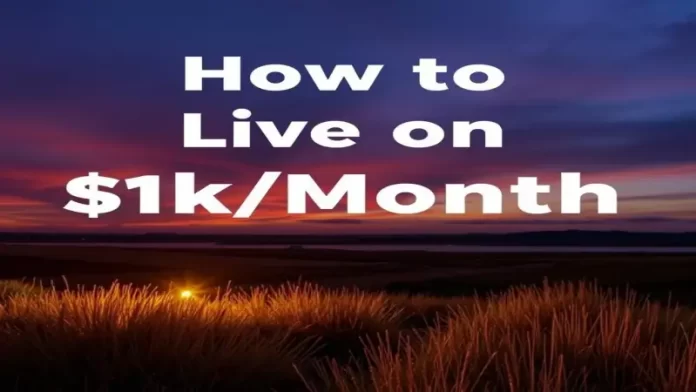Lets talk about a number that sounds both daunting and intriguing: living on $1,000 a month. reading that figure might trigger immediate panic “Impossible! How could anyone possibly survive, let alone live, on so little?” it might sound… potentially doable? Challenging, for sure, but maybe even… liberating?
And yeah, it sounds crazy. In a world constantly telling us we need more more money, more stuff, more experiences the idea of intentionally living on such a tight budget seems counterintuitive, maybe even extreme. But here’s the thing: while it’s definitely not feasible or desirable for everyone, everywhere (try living on $1k/month in central London without serious hardship!), adopting strategies to live on less, maybe even approaching that $1k mark, can unlock surprising freedoms.
It forces intentionality. It cuts through the noise of consumerism. It demands resourcefulness. For some, its a necessity born of circumstance, a daily struggle that shouldn’t be romanticized. For others, it’s a conscious choice, a path towards financial independence, early retirement (hello, lean FIRE movement!), or simply a life less dependent on the endless chase for a bigger paycheck.
So, how could someone theoretically aim for this target, and why might they find liberation in doing so? Lets unpack the practicalities and the philosophy behind extreme frugality, keeping in mind that this is a highly personalized journey, heavily dependent on location, lifestyle, health, family, and debt.
Table of Contents
Decoding the $1k/Month Life: Practical Steps & Surprising Perks
First things first: surviving on $1k USD a month ranges from ‘challenging but feasible’ in India or Southeast Asia, to ‘nigh impossible’ in major Western cities or places like Singapore or Tokyo without significant external support or pre-existing assets. Location is everything. Your mileage will vary, dramatically. This isn’t a magic formula; it’s a collection of principles and strategies.

The “How-To”: Mastering Extreme Frugality
Getting your expenses down to this level requires tackling the big rocks first usually housing, transportation, and food.
1. Housing: The Rent Renegade
This is often the biggest budget beast. Taming it is crucial.
- Location, Location, Location (LCOL): Moving to a lower-cost-of-living (LCOL) area whether a different city, a smaller town, or even just a less expensive neighborhood within your current city is the single most impactful move.
- Size Down: Do you really need that much space? Smaller apartments or rooms generally mean lower rent, utilities, and less ‘stuff’ to fill them.
- Share the Load: Housemates, co-living spaces, or renting out a room in your own place (house hacking) drastically cut costs.
- Unconventional Options: While less common everywhere, things like van life, tiny homes, or long-term house-sitting are options some explore in certain regions.
2. Transportation: Ditching the Drive (Mostly)
Cars are money pits purchase price, insurance, fuel, maintenance, parking… ouch.
- Public Transport: Embrace buses, local trains, or metros. Often significantly cheaper than owning a car.
- Human Power: Walk or cycle whenever feasible. Great for your wallet and your health! It’s amazing how much you save when fuel isnt a concern.
- Strategic Car Use: If a car is unavoidable, opt for a fuel-efficient, reliable used model. Minimize unnecessary trips. Carpool when possible.
3. Food: The Home-Cooking Hero
Eating out, ordering takeaway, even grabbing daily coffees it adds up insanely fast.
- Cook (Almost) Everything: This is non-negotiable. Restaurant meals become rare treats, not defaults.
- Meal Plan Like a Pro: Plan your meals for the week, make a shopping list, and stick to it. Reduces food waste and impulse buys.
- Embrace Simple & Staple Foods: Rice, lentils, beans, seasonal vegetables, eggs these are often cheap, nutritious bases for meals. Buying from local markets can be much cheaper than supermarkets for produce.
- Bulk Buying (Smartly): Buy non-perishables or staples you use constantly in larger quantities when on sale (if you have storage).
- Reduce Meat Intake: Meat is often one of the most expensive grocery items. Exploring vegetarian or flexitarian options saves money. The cost of groceries vary greatly depending on diet.
- Pack Your Lunch/Snacks: Avoid buying food when out and about.
4. Utilities & Bills: Slashing the Essentials
Every little bit counts here.
- Conscious Consumption: Turn off lights, unplug phantom chargers, take shorter showers, use fans instead of AC when possible.
- Negotiate & Shop Around: Regularly review phone plans, internet packages. Are you on the best deal? Can you bundle services? Do you need the fastest speed?
- Cut Subscriptions: Audit your monthly subscriptions streaming services, gym memberships you don’t use, subscription boxes. Be ruthless. Can you share accounts with family/friends?
5. Shopping & Stuff: Needs vs. Wants Warrior
Curbing consumerism is fundamental.
- Minimalism Mindset: Focus on what you need versus what you merely want. Question every potential purchase. Implement a waiting period (e.g., 30 days) before buying non-essential items.
- Secondhand First: Explore thrift stores, online marketplaces (Facebook Marketplace), clothing swaps. You can find incredible things pre-owned.
- Repair, Don’t Replace: Learn basic repair skills for clothes, electronics, or household items. Youtube is your friend here!
- DIY Attitude: From cleaning supplies to gifts, consider if you can make it yourself cheaper.
6. Entertainment & Social Life: Fun on a Budget
A tight budget doesn’t mean zero fun. It don’t mean no enjoyment! It just requires creativity.
- Free is Fantastic: Parks, beaches, libraries (books, movies, sometimes events!), hiking, free museum days, community events, window shopping (carefully!).
- Cheap Thrills: Matinee movies, picnics, potlucks with friends instead of expensive restaurant outings, game nights at home.
- Skill Swaps: Trade skills with friends (e.g., you help with tech, they help with gardening).
7. Debt: The Budget Devourer
High-interest debt (credit cards, personal loans) makes living on a tight budget almost impossible.
- Attack It: If aiming for $1k/month, aggressively paying down debt needs to be a top priority, potentially before fully hitting the $1k spending target. Use strategies like the snowball or avalanche method. This might require temporarily earning more or spending even less.
8. Income Generation (Even Small Amounts)
Sometimes, cutting expenses isn’t enough. Earning a little extra can provide crucial breathing room.
- Side Hustles: Freelancing online, tutoring, delivering food, selling crafts, participating in the gig economy even a few extra thousand rupees or hundred dollars a month makes a difference. Having skills people pay for are invaluable.
The “Why”: Finding Liberation in Less
Okay, that sounds like… a lot of work and sacrifice. So why would anyone choose this? Where’s the liberation?
- Reduced Financial Anxiety: Living well below your means, even if your means are modest, creates a buffer. You’re less vulnerable to unexpected expenses or job instability. There’s peace in knowing you don’t need a massive income to survive. Its a powerful feeling.
- Increased Freedom & Time: When your baseline expenses are low, you have options. You might be able to work fewer hours, pursue a passion project, take mini-retirements, change careers to something less stressful (even if lower paying), or achieve financial independence and retire early (Lean FIRE). Time become more valuable than money.
- Intentionality & Purpose: Stripping away the non-essential forces you to define what truly brings you joy and fulfillment. You spend money (and time) more consciously. Relationships, experiences, health, and learning often take center stage over material possessions.
- Environmental Consciousness: Lower consumption naturally leads to a smaller environmental footprint. Less driving, less flying, less buying new stuff, less waste.
- Resilience & Resourcefulness: You develop skills cooking, repairing, budgeting, negotiating, finding free fun. You become more adaptable and less reliant on external systems or high income. You learn that you can handle things.
The Unavoidable Reality Check
Let’s be crystal clear:
- It’s HARD: This requires immense discipline, planning, and ongoing effort. It’s not a passive lifestyle. Living frugally, sacrifices are often necessary.
- Location is Paramount: Again, $1k/month in London is vastly different from $1k/month in San Francisco.
- Privilege Plays a Role: Choosing this lifestyle from a position of relative security (no major debt, good health, support system) is different from being forced into it by poverty. We must acknowledge that.
- Health & Dependents: Unexpected medical bills or supporting children/family members can make this budget extremely difficult or impossible without additional income or support systems. Mental health is also key, extreme restriction can be isolating or triggering for some. It require real commitment and self-awareness.
- It’s Not Glamorous: Forget Instagram aesthetics sometimes. It might mean older clothes, a less fancy phone, saying ‘no’ to social invitations.
The Takeaway: Less Money, More Life?
Living on $1,000 a month isn’t a universal prescription for happiness or financial success. For many, it’s an unattainable goal or a harsh reality. But for those who can make it work, either by choice or necessity refined into a skill, it offers a different path.
It’s a path defined by intentionality over impulse, resourcefulness over reliance, and potentially, a profound sense of freedom from the golden handcuffs of consumer culture. Even if $1k isn’t your target, adopting some of these frugal principles cutting back on just one major expense, being more conscious about needs vs. wants, finding joy in free activities can inject a little more freedom and intention into your life, regardless of your budget. Perhaps the real liberation isn’t the specific dollar amount, but the realization that you control your spending, and by extension, have more control over your life than you might think. Something to ponder, isn’t it?

